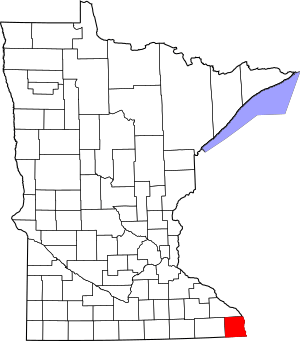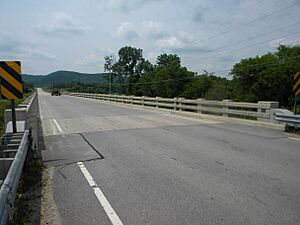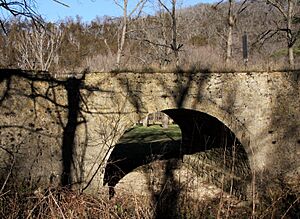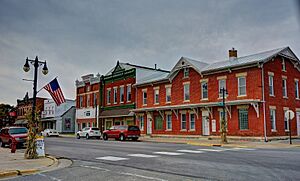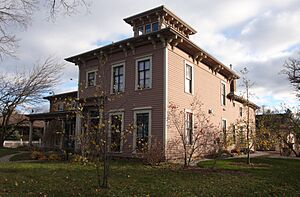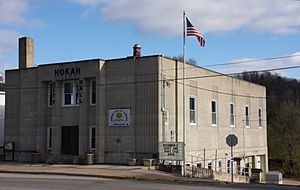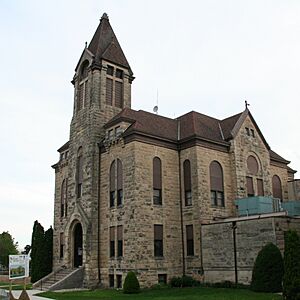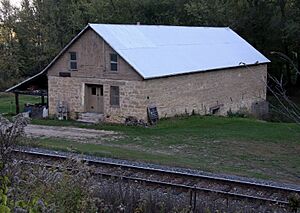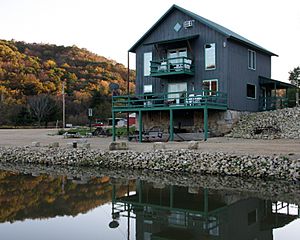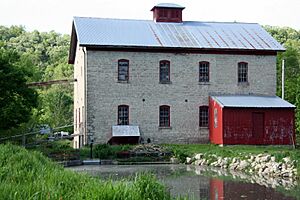National Register of Historic Places listings in Houston County, Minnesota facts for kids
Have you ever wondered about old buildings and places that tell a story? In Houston County, Minnesota, there are many special spots that are listed on the National Register of Historic Places. This is like a national list of important buildings, bridges, and sites that are worth protecting because of their history or unique design. This list helps us remember the past and learn about how people lived and worked long ago.
There are 16 places in Houston County that are currently on this special list. We'll also look at a couple of places that used to be on the list but aren't anymore.
Contents
- Historic Places to Explore
- Amazing Bridges
- Important Buildings and Stores
- Christian Bunge, Jr. Store
- Caledonia Commercial Historic District
- Daniel Cameron House
- Church of the Holy Comforter-Episcopal
- Hokah Municipal Building
- Houston County Courthouse and Jail
- Jefferson Grain Warehouse
- Johnson Mill
- Portland Prairie Methodist Episcopal Church
- Schech Mill
- David R. and Ellsworth A. Sprague Houses
- Spafford Williams Hotel
- Ancient Sites=
- Former Listings
Historic Places to Explore
Amazing Bridges
Houston County has some cool old bridges that are on the list!
Bridge No. 6679
This bridge was built in 1949. It crosses the south fork of the Root River near Houston. When it was finished, it was the longest cantilever bridge in Minnesota. A cantilever bridge is a special type of bridge that uses beams supported at only one end. This bridge shows how bridge design improved after World War II.
Bridge No. L4013
Near Spring Grove, you can find Bridge No. L4013. It's a beautiful stone arch bridge built in 1915. It's the only one of its kind left that was designed by the state highway commission back then. It's a great example of early 20th-century bridge building.
Important Buildings and Stores
Many buildings on the list show how towns grew and how people lived.
Christian Bunge, Jr. Store
In Eitzen, the Christian Bunge, Jr. Store stands out. It was built in 1890 for a German immigrant merchant named Christian Bunge, Jr. He was so important that the town of Eitzen was named after him! This building shows the history of German families in the area. Today, it's a local history museum.
Caledonia Commercial Historic District
The Caledonia Commercial Historic District includes several buildings on East Main Street and South Kingston Street in Caledonia. These buildings were built between 1872 and 1906. They are important because of their old commercial architecture. They also show how important these businesses were to the farmers in Houston County.
Daniel Cameron House
The Daniel Cameron House, built in 1871, is in La Crescent. It's known for its Italianate architecture, which is a style inspired by Italian Renaissance buildings. Daniel Cameron was a successful farmer and even a state senator. His brother, Peter, was one of the first people to settle in the area.
Church of the Holy Comforter-Episcopal
Located on Main Street in Brownsville, this church is the oldest public building in the town. It was built in 1855 and has been used for many things, including a town hall, a church, and a school. It's a key part of Brownsville's early history.
Hokah Municipal Building
The Hokah Municipal Building was built in 1938 in Hokah. It's a great example of Art Deco style, which was popular in the 1920s and 30s. This building was a project with the Works Progress Administration (WPA), a government program during the Great Depression that helped people find jobs. It served as a government building and a place for fun activities.
Houston County Courthouse and Jail
In Caledonia, you'll find the Houston County Courthouse and Jail. The jail was built in 1875, and the courthouse in 1883. The jail is an example of Italianate architecture, and the courthouse shows Romanesque Revival architecture, which uses round arches and thick walls. These buildings are important because they were the center of government for Houston County for many years.
Jefferson Grain Warehouse
The Jefferson Grain Warehouse, built in 1868, is located near Minnesota Highway 26 in Jefferson Township. This building is a rare reminder of a time when wheat was a very important crop in the Midwest. It also shows how steamboats were the main way to transport goods back then.
Johnson Mill
Near Eitzen, the Johnson Mill was built in 1877. It's one of the few old gristmills in Minnesota that still uses water power. A gristmill grinds grain, like wheat, into flour. This mill was very important for the wheat farmers in the area.
Portland Prairie Methodist Episcopal Church
This rural church was built in 1876 near Eitzen. It's known for its beautiful Eastlake Movement architecture, which is a style with lots of decorative wood details. It also connects to the early settlers from New England who came to this area.
Schech Mill
Off County Road 10 near Caledonia, you'll find Schech Mill. It was built between 1875 and 1876. This mill is very special because it's one of the few watermills left that still has its original millstones and machinery from the 1870s that still work! Today, it's a museum where you can see how flour was made long ago.
David R. and Ellsworth A. Sprague Houses
These two houses are next to each other on West Main Street in Caledonia. They were built between 1900 and 1905 for brothers David R. and Ellsworth A. Sprague. Their father, Ara D. Sprague, was a very important person in Houston County. The brothers continued their family's business and financial work.
Spafford Williams Hotel
The Spafford Williams Hotel was built in the early 1870s in Caledonia. It was an important hotel before the railroad even reached the city. It shows what early businesses and buildings in Caledonia were like. It's also part of the Caledonia Commercial Historic District.
Ancient Sites=
Some places on the list are much older than buildings.
Yucatan Fort Site
The Yucatan Fort Site is in Yucatan Township. This site has ancient Native American earthworks, which are shapes made from earth. These earthworks date back to the late Oneota period, which was a time when Native American groups lived in the Midwest before Europeans arrived. The exact location is kept private to protect the site.
Former Listings
Sometimes, places are removed from the National Register of Historic Places. This usually happens if the building is torn down or changed too much.
Eitzen Stone Barn
This barn, also called the Schroeder Stone Barn, was built south of Eitzen in the 1870s or 1880s. It was special because it was made of fieldstone, which was an unusual way to build barns. It showed the building skills of German immigrants and the importance of farming in the area. Sadly, it was torn down in 2004 and was removed from the list in 2016.
Houston County Poor Farm
The Houston County Poor Farm was built in 1893 near Caledonia. A "poor farm" was a place where people who couldn't support themselves could live and work. This building was demolished in 1988 and was removed from the list in 1990.


